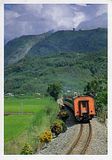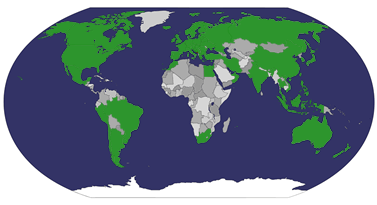
Gaudi's Building, Barcelona, Spain - Casa Milà, Temple Expiatori de la Sagrada Família, Casa Batllo ( UNESCO WHS )
Antoni Plàcid Guillem Gaudí i Cornet (25 June 1852–10 June 1926) – in English sometimes referred to by the Spanish translation of his name, Antonio Gaudí – was a Spanish Catalan architect who belonged to the Modernist style (Art Nouveau) movement and was famous for his unique and highly individualistic designs. Buildings form the majority of his works, many of which can be found in Barcelona.
Casa Milà, better known as La Pedrera (Catalan for 'The Quarry'), is a building designed by the Catalan architect Antoni Gaudí and built during the years 1906–1910, being considered officially completed in 1912. It is located at 92, Passeig de Gràcia (passeig is Catalan for promenade) in the Eixample district of Barcelona, Catalonia, Spain.
It was built for the married couple, Rosario Segimon and Pere Milà. Rosario Segimon was the wealthy widow of José Guardiola, an Indiano, a term applied locally to the Catalans returning from the American colonies with tremendous wealth. Her second husband, Pere Mila, was a developer who was criticized for his flamboyant lifestyle and ridiculed by the contemporary residents of Barcelona, when they joked about his love of money and opulence, wondering if he was not rather more interested in "the widow’s guardiola" (piggy bank), than in "Guardiola’s widow".
The design by Gaudi was not followed in some aspects. The local government objected to some aspects of the project, fined the owners for many infractions of building codes, ordered the demolition of aspects exceeding the height standard for the city, and refused to approve the installation of a huge sculpture atop the building—described as "the Virgin"—but said by Gijs van Hensbergen in his biography of Gaudi, to represent the primeval earth goddess, Gaia.
Casa Milà was in poor condition in the early 1980s. It had been painted a dreary brown and many of its interior color schemes had been abandoned or allowed to deteriorate, but it has been restored and many of the original colors revived.
The building is part of the UNESCO World Heritage Site "Works of Antoni Gaudí". The building is now owned by Caixa Catalunya.
The Temple Expiatori de la Sagrada Família (official Catalan name; Spanish: Templo Expiatorio de la Sagrada Familia; "Expiatory Temple of the Holy Family"), often simply called the Sagrada Família, is a massive, privately-funded Roman Catholic church that has been under construction in Barcelona, Catalonia, Spain since 1882 and is expected to continue until at least 2026. Considered the master-work of renowned Catalan architect Antoni Gaudí (1852–1926), the project's vast scale and idiosyncratic design have made it one of Barcelona's (and Spain's) top tourist attractions for many years. A portion of the building's interior is scheduled to open for public worship and tours by September of 2010.
Casa Batlló, is a building restored by Antoni Gaudí and Josep Maria Jujol, built in the year 1877 and remodelled in the years 1905–1907; located at 43, Passeig de Gràcia (passeig is Catalan for promenade or avenue), part of the Illa de la Discòrdia in the Eixample district of Barcelona, Catalonia.
The local name for the building is Casa dels ossos (House of Bones), and indeed it does have a visceral, skeletal organic quality. It was originally designed for a middle-class family and situated in a prosperous district of Barcelona.
The building looks very remarkable — like everything Gaudí designed, only identifiable as Modernisme or Art Nouveau in the broadest sense. The ground floor, in particular, is rather astonishing with tracery, irregular oval windows and flowing sculpted stone work.
It seems that the goal of the designer was to avoid straight lines completely. Much of the façade is decorated with a mosaic made of broken ceramic tiles (trencadís) that starts in shades of golden orange moving into greenish blues. The roof is arched and was likened to the back of a dragon or dinosaur. A common theory about the building is that the rounded feature to the left of centre, terminating at the top in a turret and cross, represents the sword of Saint George (patron saint of Catalonia), which has been plunged into the back of the dragon.
安東尼·高第-克爾內特(Antoni Gaudi i Cornet,1852年6月25日-1926年6月10日),西班牙「加泰隆現代主義Catalan Modernisme」(屬於新藝術運動,與二十世紀初的現代主義Modernism並不相同)建築家,為新藝術運動的代表性人物之一。
高第出生於雷烏斯(Reus),世代是做鍋爐的鐵匠,所以他天生具有良好的空間解構能力與雕塑感覺;又因小時患有風濕病而不能和其他小朋友一起玩耍,只能敏銳的觀察大自然,使他日後成為師法自然的建築師。高第從觀察中發現自然界並不存在純粹的直線,他曾說過:「直線屬於人類,曲線屬於上帝。」所以終其一生,高第都極力地在自己的設計當中追求自然,在他的作品當中幾乎找不到直線,大多採用充滿生命力的曲線與有機型態的物件來構成一棟建築。
他是五兄弟中的老么,受到父親的鼓勵而到巴塞隆納讀建築系。1878年瓷磚商麥諾·畢森(Manuel Vicens)委託高第設計一棟避暑別莊,叫做文生之家 (Casa Vicens),高第從此開始了自己的設計生涯。然而文生之家並不是高第最經典的作品,高第在接下來的幾個作品當中,才漸漸樹立起自己獨一無二的建築風格。1878年高第也認識了他最重要的贊助者,顯赫的桂爾先生(Guell),桂爾先生驚於高第的天才,從此委託高第設計墓室、殿堂、宅邸、亭台等,使高第能充分自由地表現自我,發揮才華。高第的許多作品除了表現極強烈的個人風格之外,也對往後的現代設計乃至於後現代建築設計提供了許多養分。
高第終生未娶,除了工作,沒有任何別的愛好和需求,神聖家族教堂是他最偉大的作品,他把一生中的43年都貢獻在那裡,1925年還乾脆搬到教堂的工地去住,全心全意研究教堂的結構設計,1926年6月7日的下午,高第完成當天的工作從神聖家族教堂到市中心的教堂做禮拜,被一輛電車撞倒,當時他衣衫破舊,路人以為是流浪漢,把他送到聖十字醫院,三天後去世了,大家才發現流浪漢竟是高第,為他舉行了個很隆重的葬禮,送葬的隊伍從聖十字醫院一直緩緩的延伸到了神聖家族教堂,把他安葬在他未完成的神聖家族教堂地下。
米拉之家(Casa Milà,經常被稱為La Pedrera(加泰羅尼亞語,意為「採石場」))是著名的西班牙現代主義建築師安東尼·高第的作品之一,坐落在西班牙的巴塞隆納市區裡的Eixample 擴建區、格拉西亞大道(Passeig de Gràcia)上。這棟建築是建於1906年至1912年間,當時是富豪米拉先生(Pere Milà)因非常欣賞高第為巴特由先生設計的巴特由之家CASA BATLLÓ ,為了和富孀 Roser Segimon 結婚,而請高第設計的。聯合國教科文組織在1984年將包括米拉之家在內的幾個高第設計的建築列入世界遺產中。
米拉之家設計的特點是『它本身建築物的重量完全由柱子來承受,不論是內牆外牆都沒有承受建築本身的重量,建築物本身沒有主牆』,所以內部的住宅可以隨意隔間改建,建築物不會塌下來,而且,可以設計出更寬大的窗戶,保證每個公寓的采光。當時米拉夫婦出錢建這房子,一樓是出租的店舖,二樓叫「主樓」(Piso Principal),是米拉夫婦住的,三、四、五、六樓是出租的住宅,因為高第設計的力學結構很特別,建築物的重量完全由柱子來承受,所以出租的每一層樓的隔間佈局都不一樣,三樓隔出三戶住家,四樓隔出四戶住家,五樓隔出四戶住家,六樓隔出三戶住家,每戶住家佔地也不一樣,最大600平方公尺,最小 290平方公尺。頂樓是用來調節溫度,曬衣服用的。屋頂陽台則類似高第的另一個作品桂爾公園(PARC GÜELL)中似蛇般的長椅,有30個奇特的煙囪,2個通風口,與6個樓梯口,塔狀的樓梯口形狀最大,螺旋梯裡面暗藏水塔。
大多數參觀過這棟建築的人可能會認為米拉之家是壯麗且氣勢凌人的,也有人對波浪狀的外牆覺得太古怪,但,無論如何,米拉之家現在是巴塞隆納市的地標之一。
神聖家族教堂(簡稱聖家堂,全名神聖家族贖罪教堂 - Templo Expiatorio de la Sagrada Familia)是西班牙巴塞羅那的一個教堂,從1882年修建,因為是贖罪教堂,資金的來源主要靠捐款,捐款的多少直接影響到工程進度的快慢,所以至今還未完工,是世界上唯一一個,還未完工就被列為世界遺產的建築物。這個教堂不是大主教做弥撒的地方,所以不是大教堂,只是個設計別的教堂而已,而且,雖然已建了126年還未完工,但和德國耗時 600 年才建好的科隆大教堂比起來,根本算不上「世界上耗時最長的工程」。
神聖家族教堂的建築屬於西班牙「加泰隆現代主義Catalan Modernisme」(屬於新藝術運動,與二十世紀初的現代主義Modernism並不相同)建築,1882年動工時,由 Josep Maria Bocabella 領導的 Asociación Josefina y del Templo 宗教團體出錢,由建築師 Francesc de Paula del Villar 開始興建,一年後,建築師 Francesc de Paula del Villar 因設計的教堂成本太高,和宗教團體意見不合,辭職而去,才由年僅 31 歲的安東尼·高第接手。高第接手後,聖壇地下室已在建造中,無法修改設計圖,所以他按照第一任建築師 Francesc de Paula del Villar 的設計圖建完聖壇地下室,然後把整個教堂重新設計,把 Francesc de Paula del Villar 原先設計的新哥德式教堂改為加泰隆現代主義建築。高第一生 43 年的心血都花在這個教堂的設計上,1925年後還乾脆搬到教堂的工地去住,全心全意設計教堂,直到 1926 年他遇車禍死亡為止,一直不斷的研究教堂的結構設計,去世時留下了許多寶貴的資料、設計稿和模型,但是在西班牙內戰時被毀壞,而工程也停頓到1954年才再次動工。
這個教堂的設計帶有強烈的自然色彩,高第以很多動植物的形態為藍本來設計教堂,更以《聖經》中的各個場景在整個建築中如同圖畫一樣逐幅展現,使這個教堂成為每個來訪者都可以讀到的一本教義問答書。
這個教堂有東、西、南三個門面:「誕生門面」、「受難門面」和「榮耀門面」。每個門面都會建有四座鐘塔,共計十二座,分別代表耶穌的十二個門徒。除此之外,建築的中央另有六座高塔,其中四座代表聖經四福音作者,馬太、馬可、路加以及約翰,一座代表聖母瑪利亞,一座代表耶穌基督。所以整個聖家堂的設計當中總共將建造十八座高塔 。代表門徒的十二座高塔的高度介於 98.4 米 和 117 米,代表福音作者的四座高塔高達 120 米,代表聖母瑪利亞的高塔高達 120 米,代表耶穌基督的高塔高達 170 米。
大部分的設計都未在高第生前真正建成。聖壇地下室建於 1889 - 1892 年,「誕生門面」建於 1892 - 1930 年,高第去世於 1926 年,「受難門面」建於 1954 - 1977 年,偏殿和中殿建於 1978 - 2000 年,「榮耀門面」還在建造當中,教堂中間的六座高塔還沒開始建造。
現在已建好、可以參觀的是「誕生門面」和「受難門面」。「誕生門面」以基督的誕生為題,牆上的雕塑展現了由童貞瑪利亞懷胎到基督長成的故事,因是歡迎慶祝基督誕生,以歡喜愉悅的雕塑為主。「受難門面」以基督的死亡為題,高第為了表現受難的痛苦,設計了有棱有角的現代線條,雕刻家 Josep M. Subirachs 按照高第留下的圖稿刻出了由最後的晚餐到基督被釘十架,到基督升天的故事
從高第以後,現在的建築師 Jordi Bonet 已是第四代了,目前,三個門面已建好「誕生門面」和「受難門面」,十八座高塔已建好「誕生門面」的四座鐘塔和「受難門面」的四座鐘塔,還差十座高塔,整個建築完成了將近50%,預計還要二、三十年才會完工。
巴特洛公寓(Casa Batlló)是建筑师安东尼·高迪设计的一座建筑,建造于1905年到1907年间。位于西班牙巴塞罗那埃克萨潘区(Eixample)的加西亚大街(Passeig de Gárcia)43号。2005年被扩充入世界遗产安东尼·高迪的建筑作品中。
巴特洛公寓有两个阁楼开放。位于楼顶的“龙腹”("The Dragon's Belly")中,高迪使用了其精巧的悬链拱。而“火的空间”("The Fire Space"),则是由当代建筑师英葛·摩利尔(Ingo Maurer)设计的,是一个灯光与视觉的奇幻空间。其余各处仿佛真实的童话,愉快而怀旧,散发着巴塞罗那浓郁的现代主义生活气息。在这里,成人与孩童一样都会浮想联翩。烟囱在晚上会亮起灯光。在屋顶400m2的露台上,可以享受地中海式的户外生活和巴塞罗那的怡人气候。
References sources : wikipedia






























 Postcards received from
Postcards received from 








































































2 comments:
These buildings look so great. Thank you.
Hi, Claire, Thank you for your nice comment! I like Antonio Gaudí buildings very much, I hope to visit Barcelona in the future...
Post a Comment